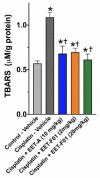Kidney-Targeted Epoxyeicosatrienoic Acid Analog, EET-F01, Reduces Inflammation, Oxidative Stress, and Cisplatin-Induced Nephrotoxicity
- PMID: 33801911
- PMCID: PMC7998941
- DOI: 10.3390/ijms22062793
Kidney-Targeted Epoxyeicosatrienoic Acid Analog, EET-F01, Reduces Inflammation, Oxidative Stress, and Cisplatin-Induced Nephrotoxicity
Abstract
Although epoxyeicosatrienoic acid (EET) analogs have performed well in several acute and chronic kidney disease models, targeted delivery of EET analogs to the kidney can be reasonably expected to reduce the level of drug needed to achieve a therapeutic effect and obviate possible side effects. For EET analog kidney-targeted delivery, we conjugated a stable EET analog to folic acid via a PEG-diamine linker. Next, we compared the kidney targeted EET analog, EET-F01, to a well-studied EET analog, EET-A. EET-A or EET-F01 was infused i.v. and plasma and kidney tissue collected. EET-A was detected in the plasma but was undetectable in the kidney. On the other hand, EET-F01 was detected in the plasma and kidney. Experiments were conducted to compare the efficacy of EET-F01 and EET-A for decreasing cisplatin nephrotoxicity. Cisplatin was administered to WKY rats treated with vehicle, EET-A (10 mg/kg i.p.) or EET-F01 (20 mg/kg or 2 mg/kg i.p.). Cisplatin increased kidney injury markers, viz., blood urea nitrogen (BUN), N-acetyl-β-(D)-glucosaminidase (NAG), kidney injury molecule-1 (KIM-1), and thiobarbituric acid reactive substances (TBARS). EET-F01 was as effective as EET-A in decreasing BUN, NAG, KIM-1, TBARS, and renal histological injury caused by cisplatin. Despite its almost 2×-greater molecular weight compared with EET-A, EET-F01 was comparably effective in decreasing renal injury at a 10-fold w/w lower dose. EET-F01 decreased cisplatin nephrotoxicity by reducing oxidative stress and inflammation. These data demonstrate that EET-F01 targets the kidney, allows for a lower effective dose, and combats cisplatin nephrotoxicity. In conclusion, we have developed a kidney targeted EET analog, EET-F01, that demonstrates excellent potential as a therapeutic for kidney diseases.
Keywords: chemotherapy; epoxyeicosatrienoic acid; kidney-targeted; nephrotoxicity; novel therapy.
Conflict of interest statement
John D. Imig, Md. Abdul Hye Khan, Adeniyi Adebesin, and John R. Falck have patents that cover the composition of matter for EET-A and EET-F01. The authors declare no other conflict of interest, financial or otherwise.
Figures







Similar articles
-
Novel orally active epoxyeicosatrienoic acid (EET) analogs attenuate cisplatin nephrotoxicity.FASEB J. 2013 Aug;27(8):2946-56. doi: 10.1096/fj.12-218040. Epub 2013 Apr 19. FASEB J. 2013. PMID: 23603837 Free PMC article.
-
14, 15-EET induces breast cancer cell EMT and cisplatin resistance by up-regulating integrin αvβ3 and activating FAK/PI3K/AKT signaling.J Exp Clin Cancer Res. 2018 Feb 9;37(1):23. doi: 10.1186/s13046-018-0694-6. J Exp Clin Cancer Res. 2018. PMID: 29426357 Free PMC article.
-
Betaine supplementation mitigates cisplatin-induced nephrotoxicity by abrogation of oxidative/nitrosative stress and suppression of inflammation and apoptosis in rats.Exp Toxicol Pathol. 2015 Feb;67(2):133-41. doi: 10.1016/j.etp.2014.11.001. Epub 2014 Dec 6. Exp Toxicol Pathol. 2015. PMID: 25488130
-
Orally Active Epoxyeicosatrienoic Acid Analogs.J Cardiovasc Pharmacol. 2017 Oct;70(4):211-224. doi: 10.1097/FJC.0000000000000523. J Cardiovasc Pharmacol. 2017. PMID: 28937442 Free PMC article. Review.
-
Epoxyeicosatrienoic acids, hypertension, and kidney injury.Hypertension. 2015 Mar;65(3):476-82. doi: 10.1161/HYPERTENSIONAHA.114.03585. Epub 2015 Jan 12. Hypertension. 2015. PMID: 25583156 Free PMC article. Review. No abstract available.
Cited by
-
Direct targeting of sEH with alisol B alleviated the apoptosis, inflammation, and oxidative stress in cisplatin-induced acute kidney injury.Int J Biol Sci. 2023 Jan 1;19(1):294-310. doi: 10.7150/ijbs.78097. eCollection 2023. Int J Biol Sci. 2023. PMID: 36594097 Free PMC article.
-
TPPU Downregulates Oxidative Stress Damage and Induces BDNF Expression in PC-12 Cells.Comput Math Methods Med. 2022 Jul 13;2022:7083022. doi: 10.1155/2022/7083022. eCollection 2022. Comput Math Methods Med. 2022. Retraction in: Comput Math Methods Med. 2023 Aug 2;2023:9863231. doi: 10.1155/2023/9863231. PMID: 35872930 Free PMC article. Retracted.
-
Epoxyeicosatrienoic acid administration or soluble epoxide hydrolase inhibition attenuates renal fibrogenesis in obstructive nephropathy.Am J Physiol Renal Physiol. 2023 Feb 1;324(2):F138-F151. doi: 10.1152/ajprenal.00052.2022. Epub 2022 Dec 8. Am J Physiol Renal Physiol. 2023. PMID: 36475868 Free PMC article.
-
Soluble Epoxide Hydrolase Inhibition Attenuates Proteinuria by Alleviating Renal Inflammation and Podocyte Injuries in Adriamycin-Induced Nephropathy.Int J Mol Sci. 2024 Oct 2;25(19):10629. doi: 10.3390/ijms251910629. Int J Mol Sci. 2024. PMID: 39408958 Free PMC article.
-
New Alkoxy- Analogues of Epoxyeicosatrienoic Acids Attenuate Cisplatin Nephrotoxicity In Vitro via Reduction of Mitochondrial Dysfunction, Oxidative Stress, Mitogen-Activated Protein Kinase Signaling, and Caspase Activation.Chem Res Toxicol. 2021 Dec 20;34(12):2579-2591. doi: 10.1021/acs.chemrestox.1c00347. Epub 2021 Nov 24. Chem Res Toxicol. 2021. PMID: 34817988 Free PMC article.
References
MeSH terms
Substances
LinkOut - more resources
Full Text Sources
Other Literature Sources
Medical

